Serifos Island: A Throw of the Autumn Dice, Part 2

“Early on, in our stay, we were a bit less wary of the challenges presented by driving on Serifos. Approaching the main habitation, Hora, from the east, and thinking to avoid driving first south and then north to make our ascent, we trusted to GPS, as opposed to an analog map . . . GPS assuring us that there was an approach by paved road from Hora’s east flank. Reader, we took that road, with Siri telling us over and over to keep on going. I should mention here that the designated driver (I) was driving a largish car rented just the day previous, a car with a push-button parking brake, or EPB.”—Elizabeth Boleman-Herring
Hapax Legomenon
By Elizabeth Boleman-Herring
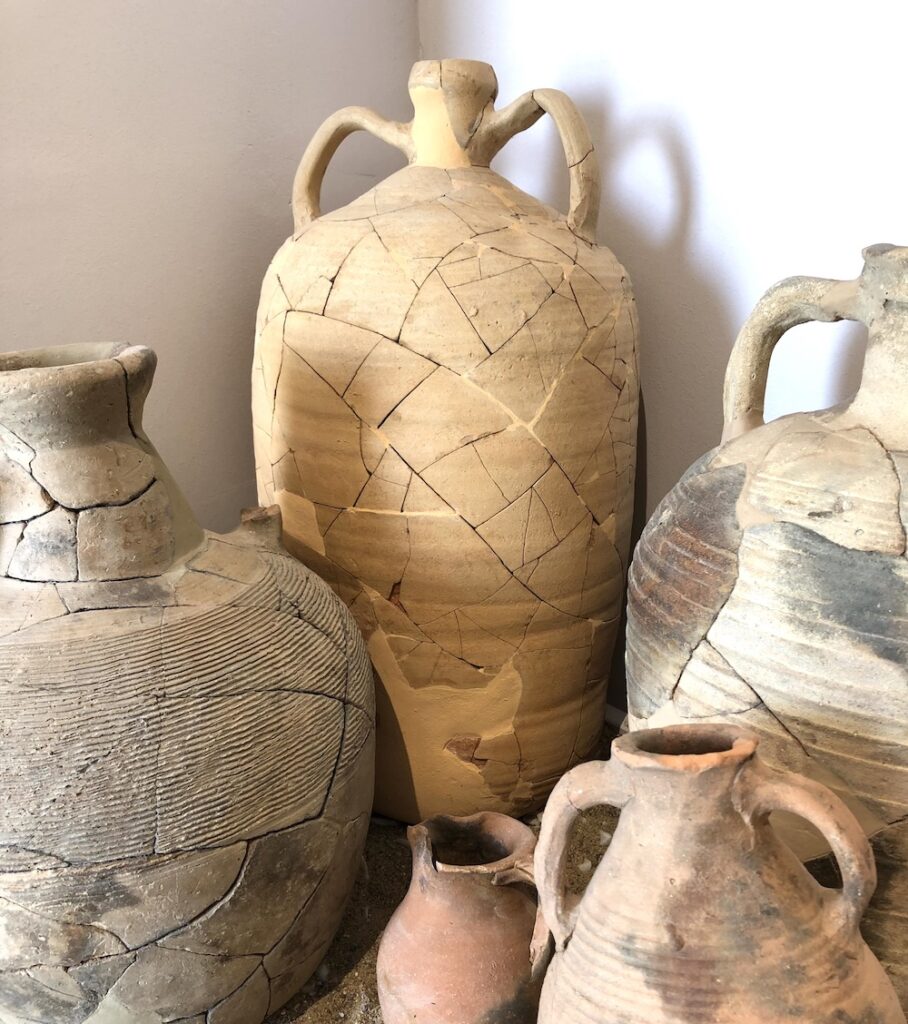
“The town, the villages, the buildings, the shapes, the mountains, the trees, the birds, the churches, the terraces, the fields, the fruits, the gorges, the meadows, the herbs, the flowers, the beaches, the rocks, the caves, the cliffs, the footprints, the rocks, the mines, the colors . . . .” Panayotis Filippopoulos, Serifos Above
Author’s Note: Read the first part of this travel essay, which ran in the November 2023 issue of “Hubris,” here.
PENDLETON South Carolina—(Hubris)—December 2023—What was most remarkable about Serifos for me was what the island has to offer . . . underwater. All this winter-to-come, with my eidetic sense memory (both gift and curse), I will be back, submerged in the clear West-Cycladic Aegean, among the octopuses, cuttlefish, Wide-eyed flounders, Ornate Wrasses, Saddled seabream, Mediterranean Damselfish (so matte-black they seem two-dimensional) and schools of tiny translucent sand smelt. The seas off Serifos, unlike Mykonian seas, are still vibrantly alive with flora and fearless fauna. One of the octopuses we saw was holed up in a rocky fastness just ankle-deep off Aghios Sostis and was to be found there for the duration of our three weeks on the island, too shallowly situated and canny to be noticed by spearfisherman foraging much farther afield.
We spent as much time as we could in the water, given the exigencies of hiking and driving out and down to (and up from) many, many of Serifos’s 50-odd beaches. In the case of distant Sykamia, we were so worn out by the hairpins-and-needles drive and had allowed so little time for a swim between getting there and starting out for home again before dark, that we had to content ourselves with a walk and a long chat with the young woman—alone, this late in the season—at the sole beach taverna. She was so starved for conversation (about Trump, Biden, wildfires, inflation, the terrible state of things in the larger world), and so beset by pre-verbal toddlers, that we hated to leave her.
Often, we would arrive at a distant destination—Vagia Beach, for example, where we’d hoped to dine at the Coco-MAT Eco Residences Hotel complex—only to realize that the fierce wind blowing up from the southwest made swimming there on windy days impossible (and that the drive over from our lodging in Tsilipakis, after dark, down unlighted and narrow barely-paved roads made returning there for drinks and dinner equally impossible). The beach was breathtakingly beautiful, but we could not imagine wanting to be there for any length of time, far, far away from other living souls, restaurants, groceries . . . even streetlamps.
Early on, in our stay, we were a bit less wary of the challenges presented by driving on Serifos. Approaching the main habitation, Hora, from the east, and thinking to avoid driving first south and then north to make our ascent, we trusted to GPS, as opposed to an analog map . . . GPS assuring us that there was an approach by paved road from Hora’s east flank. Reader, we took that road, with Siri telling us over and over to keep on going.
I should mention here that the designated driver (I) was behind the wheel of a largish car rented just the day previous, a car with a push-button parking brake, or EPB. (Paul Zangari: “To many, electrically operated parking brakes are the answer to a question nobody asked.”) My navigator was holding her phone (the source of all-things-Siri), and Siri was soon describing a road that corresponded in no way with what we all saw coming up through our windshield. We ascended on a concrete track that narrowed dramatically as we went along, passing Hora’s main cemetery on the right. (“They wouldn’t put the cemetery on a road no large vehicle could access,” I reasoned to myself.) Soon, we were ascending at a very smart incline off plumb, and concrete walls—not tall ones, but, still, walls—appeared on both sides of us.
We reached a crossroads of sorts where the only egress was up, at an acute angle, to our right. You’ll just have to take my word for it that there was no possibility of backing out and down. I began to take the turn up . . . when the car stalled, and here is where the EPB returns to our story. The car stalled, and then rolled back down into that not-tall wall to our left, which we now saw had concealed a drop into the front yard of a concrete house. Our wheels were now wedged into that wall; and the driver’s side doors abutted it. Behind the wall, the man and woman of the house observed our situation, silently.
After asking that all my occupants exit the vehicle through the doors one could still open (if I were going into the abyss, I would go alone, without Louise, The Tin Man, and Toto), I began to attempt to engage and disengage the EPB in order to gain a bit of uphill purchase. It was not to be.
In the grand tradition of rural Greeks, most of whom recognize an imminent disaster for what it is, and who wish to spare those in extremis the added humiliation of an audience, the homeowners had now retreated from view. In the driver’s seat, I had given up and was searching my phone (no cellular service in that particular crevasse, I found), when a man of a certain age came into view, entering the tiny square from Stage Left and downhill. He literally appeared, like a deus ex machina.
In a glance, he had assessed the situation. About eye-level with me through the driver’s side window, he asked, in Greek, “GPS?” to which I nodded in assent.
“Oh, and there’s a push-button parking brake,” I added.
“I’ve heard of those,” he said. “Terrible idea!”
Then, I watched him wait a beat; so, so very much expressed in the length of his hesitation.
Meanwhile, my passengers and our small dog were standing to one side, silent members of the dramatis personae, and also very obviously fearful, hot, tired, and a long way from home.
Panagiotis, or “All Saints’,” for that is his name, then let the die be cast: “Would you like me to drive it up for you?”
“Would you?” I stammered.
“Sure. I have a much bigger car and do this all the time,” he said, very, very softly.
So, I eased myself out through the passenger-side door, and Panagiotis eased himself in, and after swearing, again, very softly, at the EPB, he managed to throw the behemoth into gear and roar straight uphill to Hora’s lower square, where he exited, Stage Left again, handing me the keys.
We asked him to accompany us somewhere for dinner, a drink, anything, but he said he had work, obligations; and then, he was gone. We, all of us, were not sure at all that he had been real, or whether we, and our situation, had not instead conjured him.
But he lives and breathes.
Another day, down at the port, we were walking along en masse, (and we—man, two women, small dog— are pretty hard to mistake for anyone else), when we were hailed by someone we imagined to be a stranger. We were puzzled—we knew practically no one on the island—but then the navigator realized it was Panagiotis (Filippopoulos). We stopped and, not fearing for life nor limb for the moment, talked with him at some length. Turns out he’s an island-famous photographer, whose beautiful book of aerial/drone photographs of Serifos is titled Serifos Above. There was just one copy left at a nearby gift shop, so we bought Panagiotis’s book, and he signed it for us, right there on the quay.
The navigator told Panagiotis that the driver (I) had imagined him not to be real but, rather, some sort of divine agent, dropped from the sky to save us in our moment of need. Panagiotis was shyly amused. And we have escaped to tell future visitors to the island: 1) Never trust GPS on Serifos; and 2) Do not rent a car with an EPB, anywhere, ever.
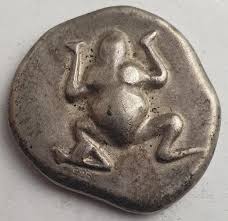
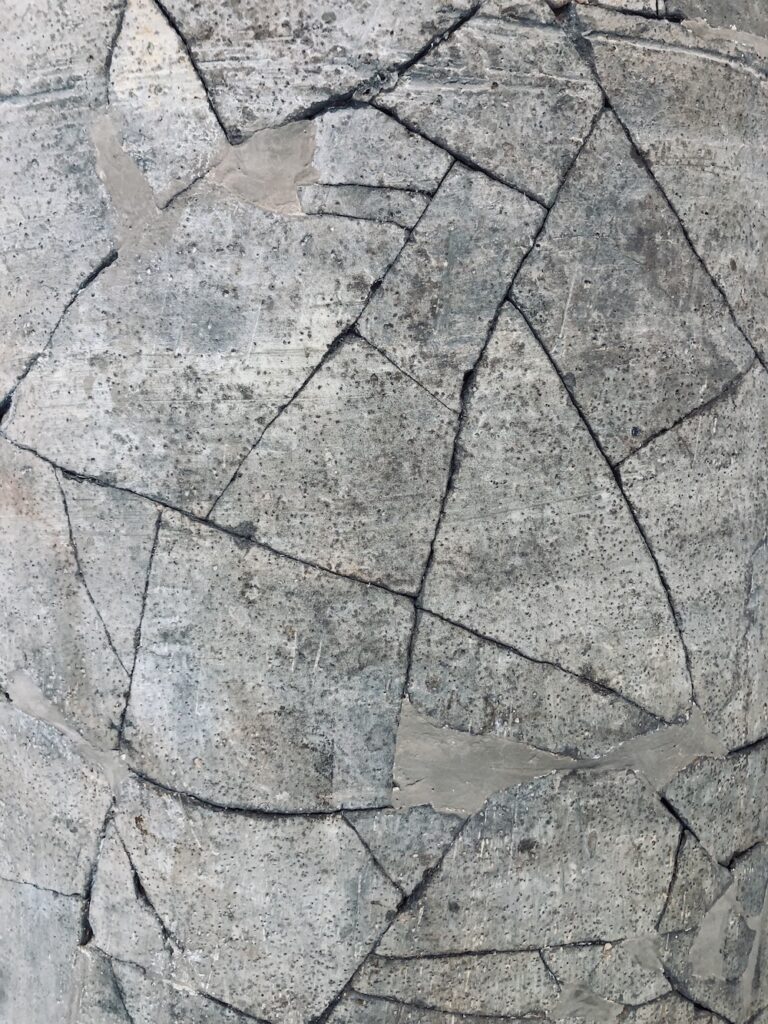
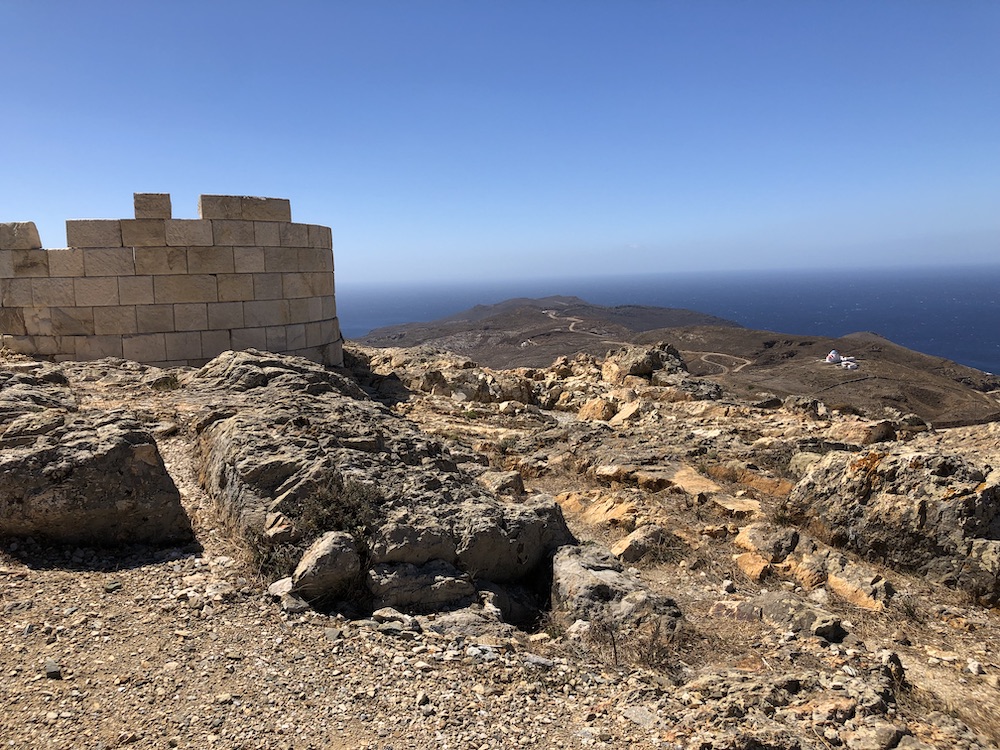
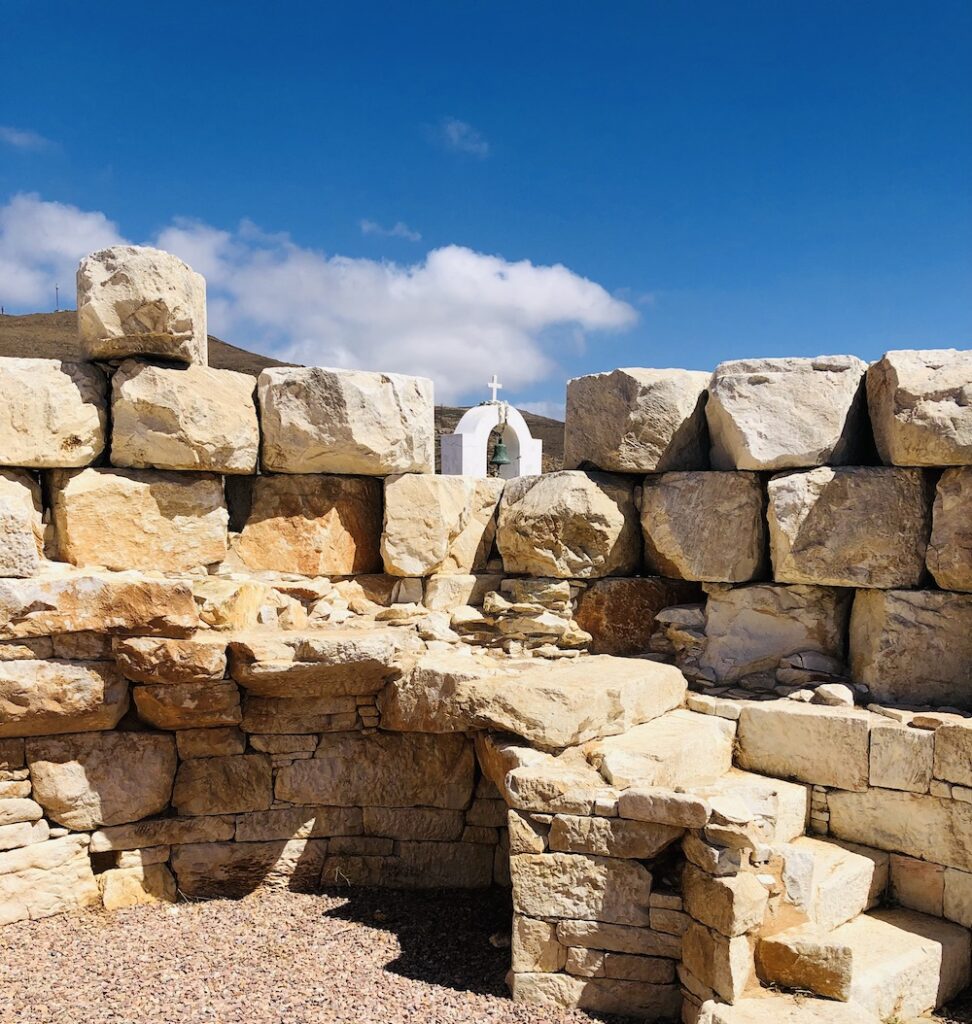
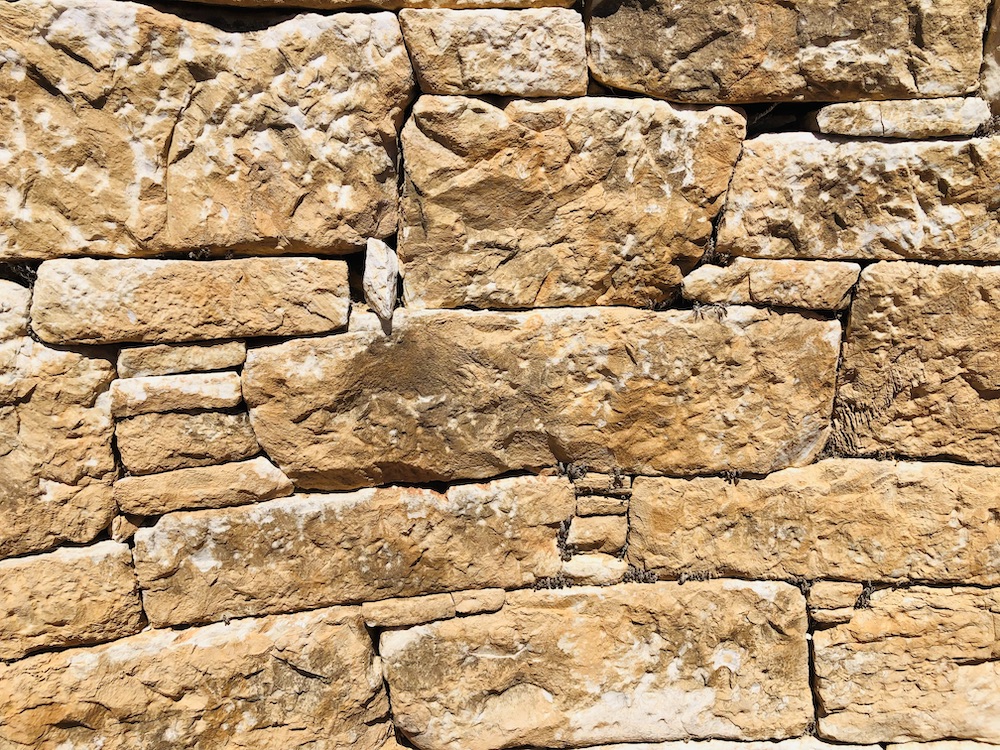
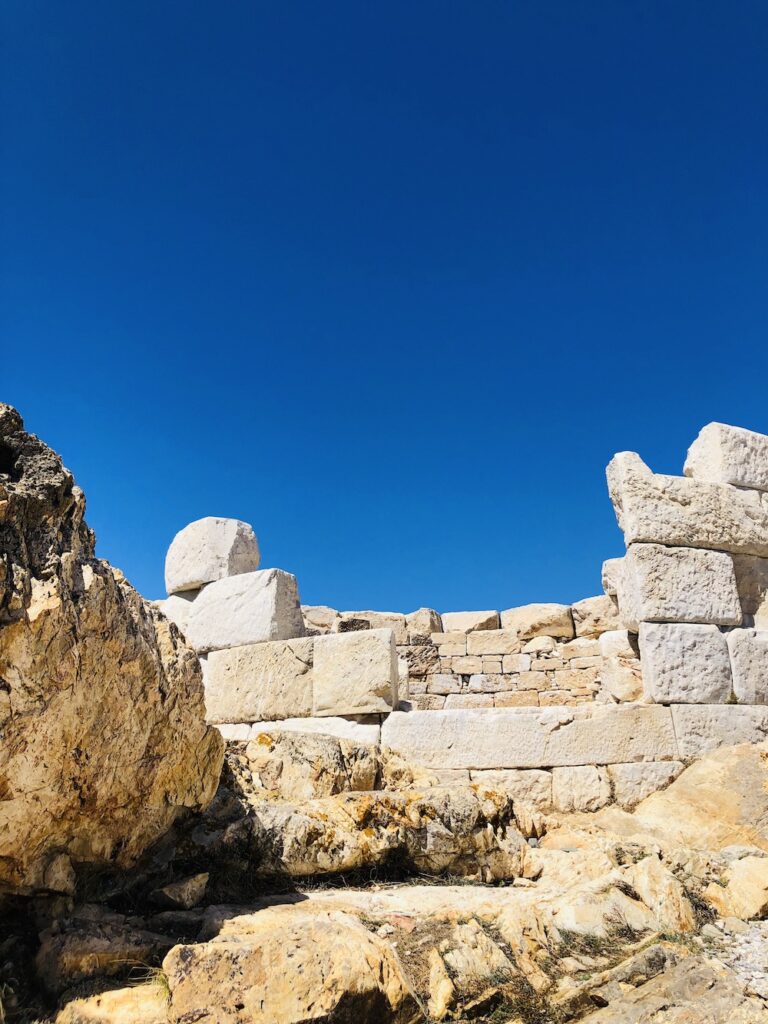
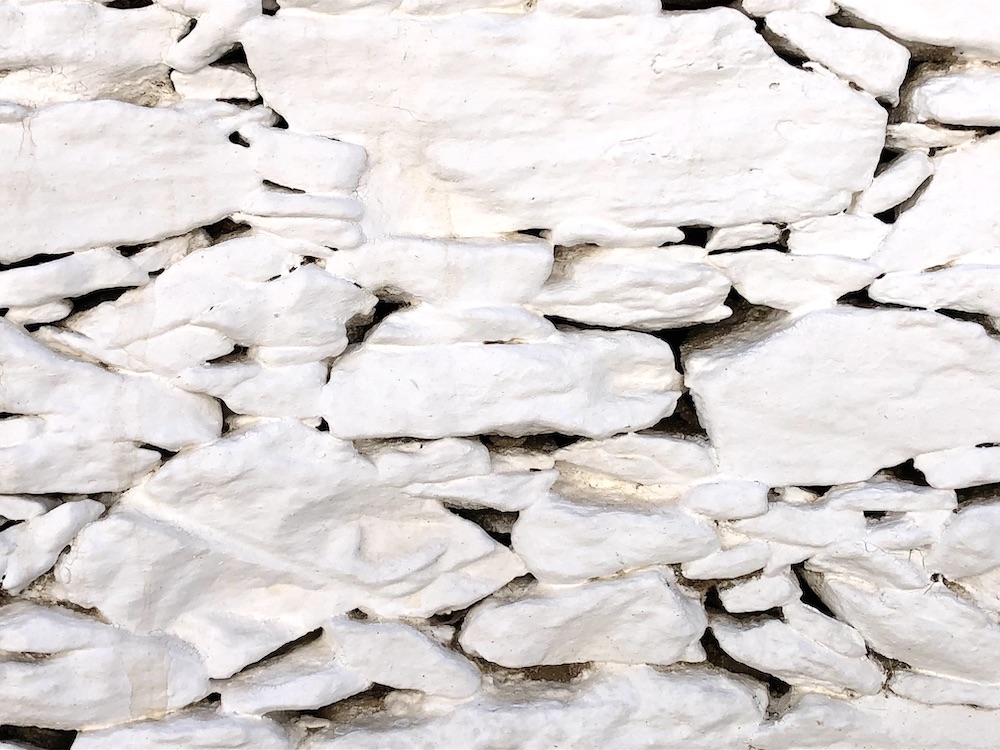
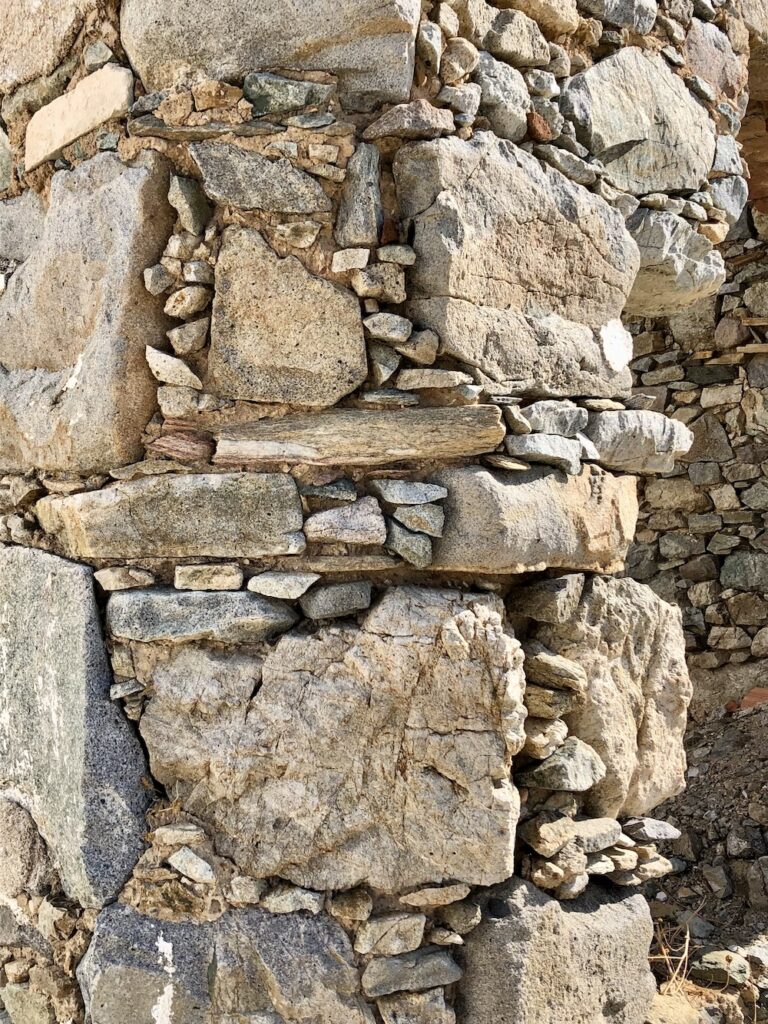
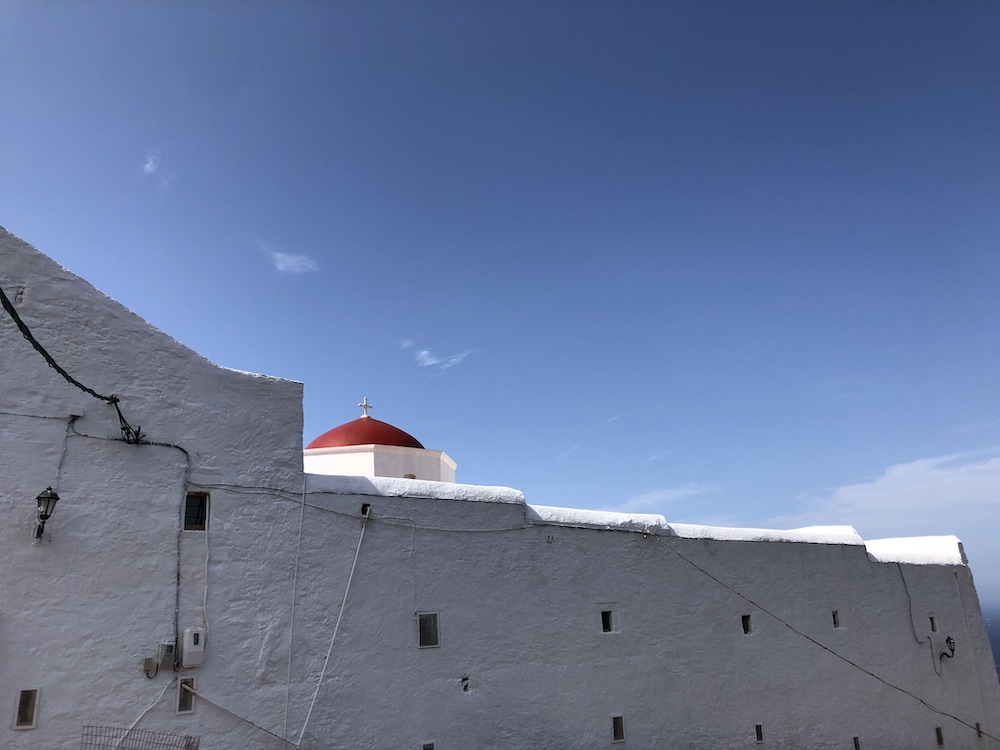
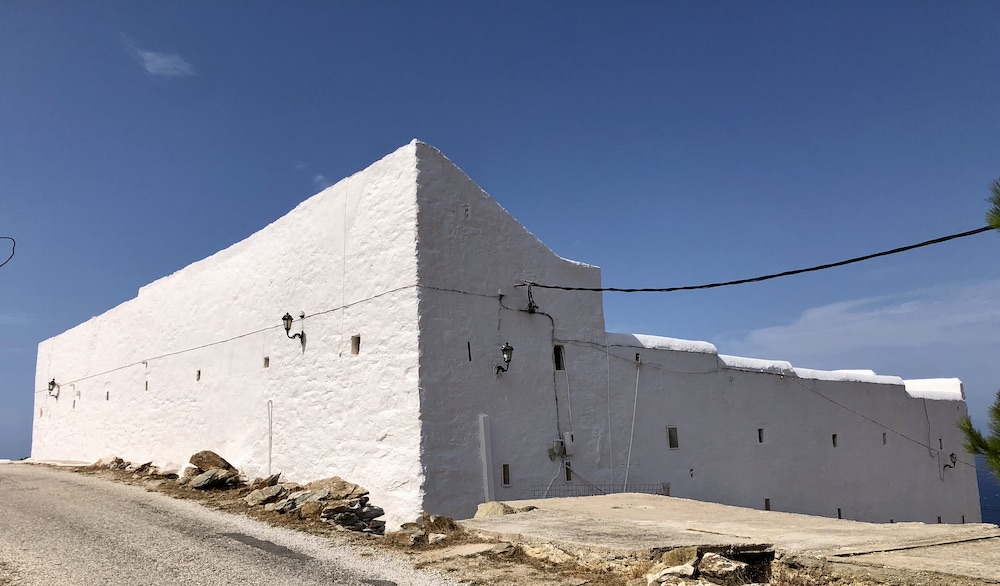
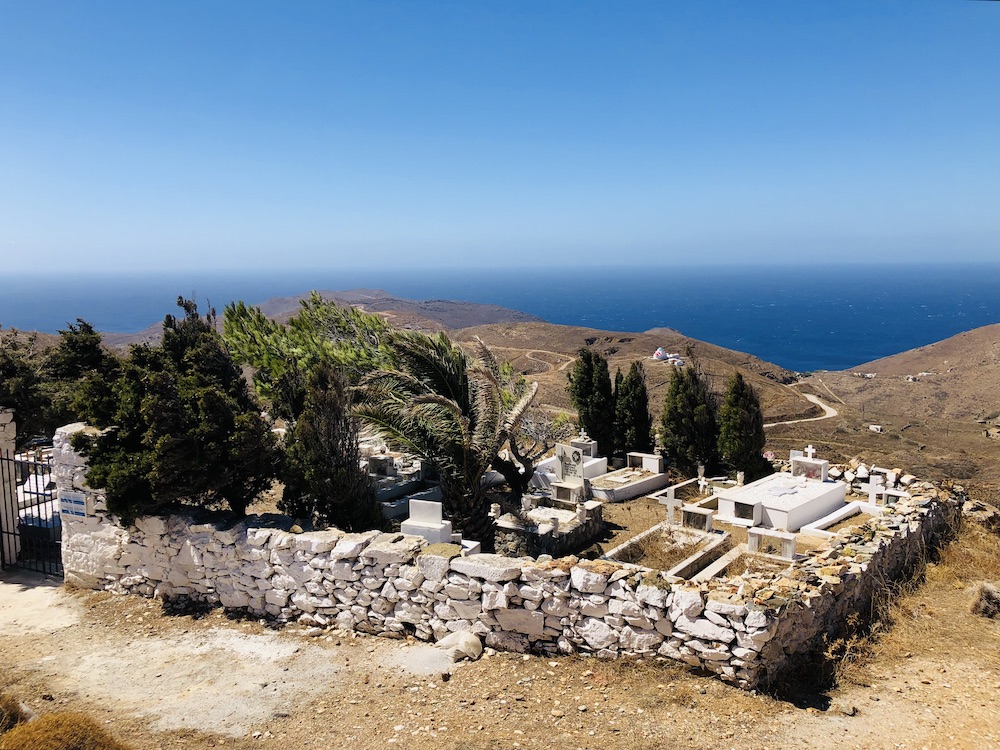
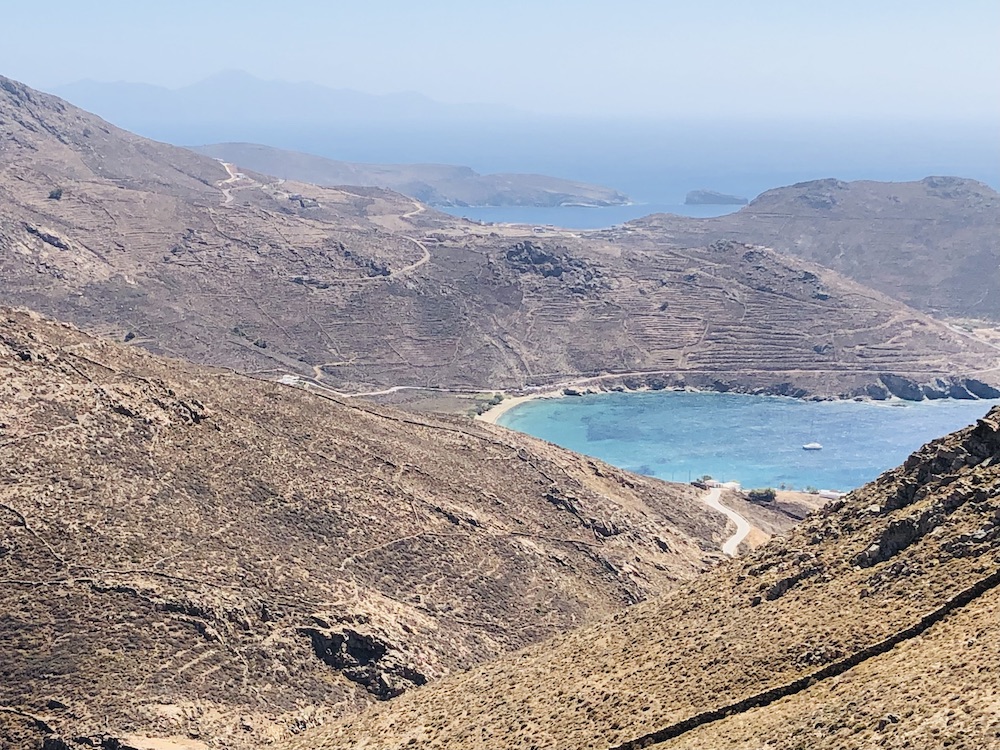
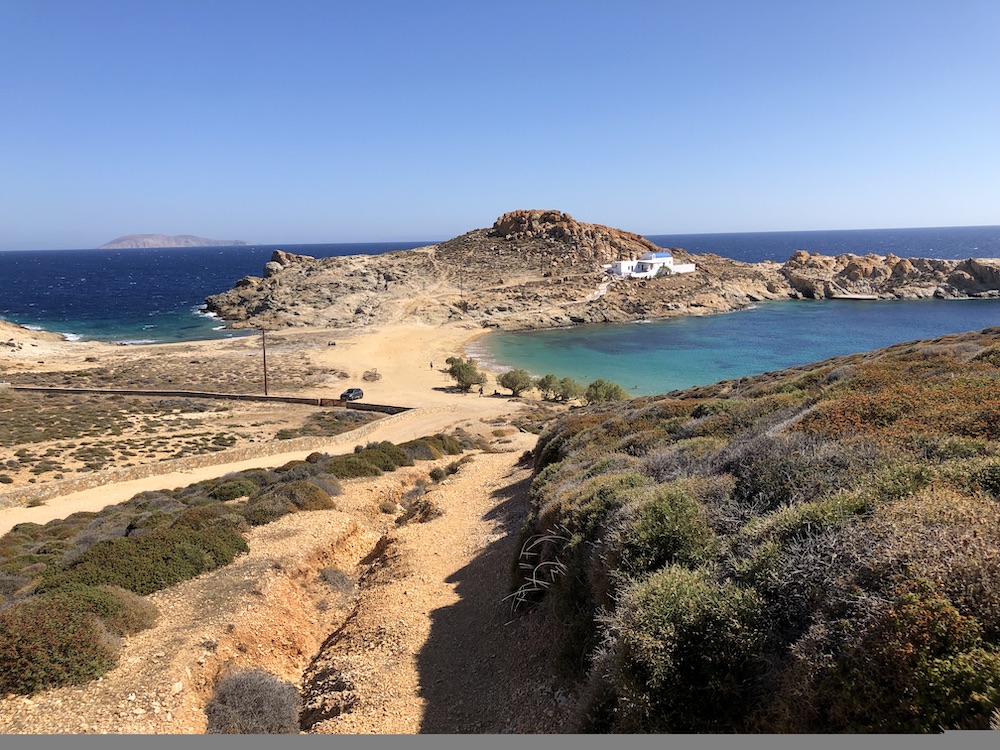
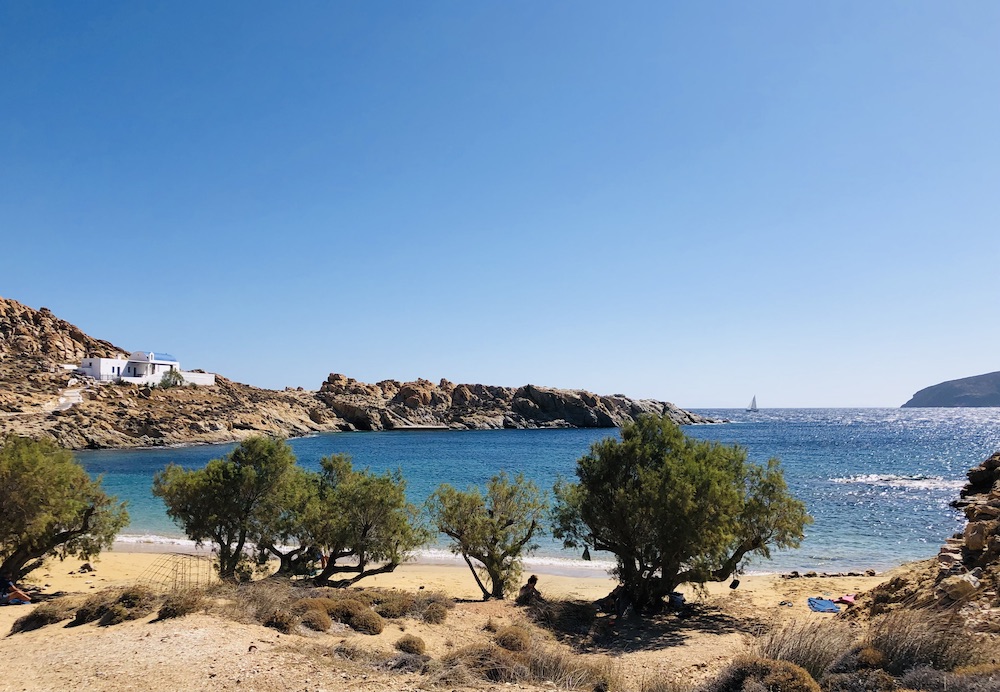
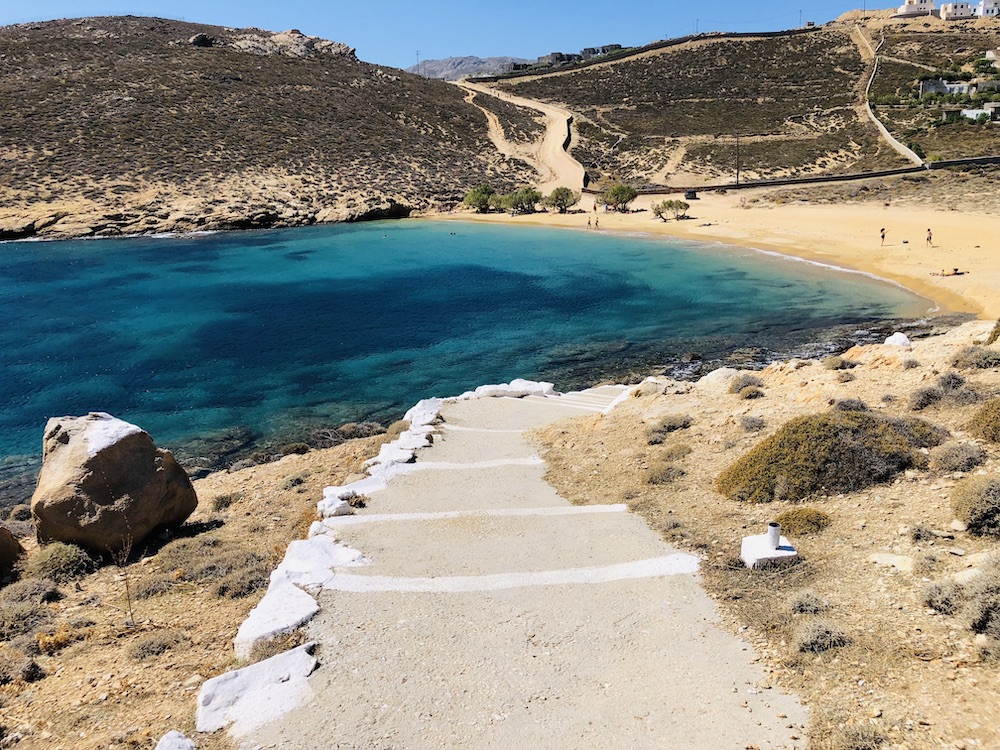

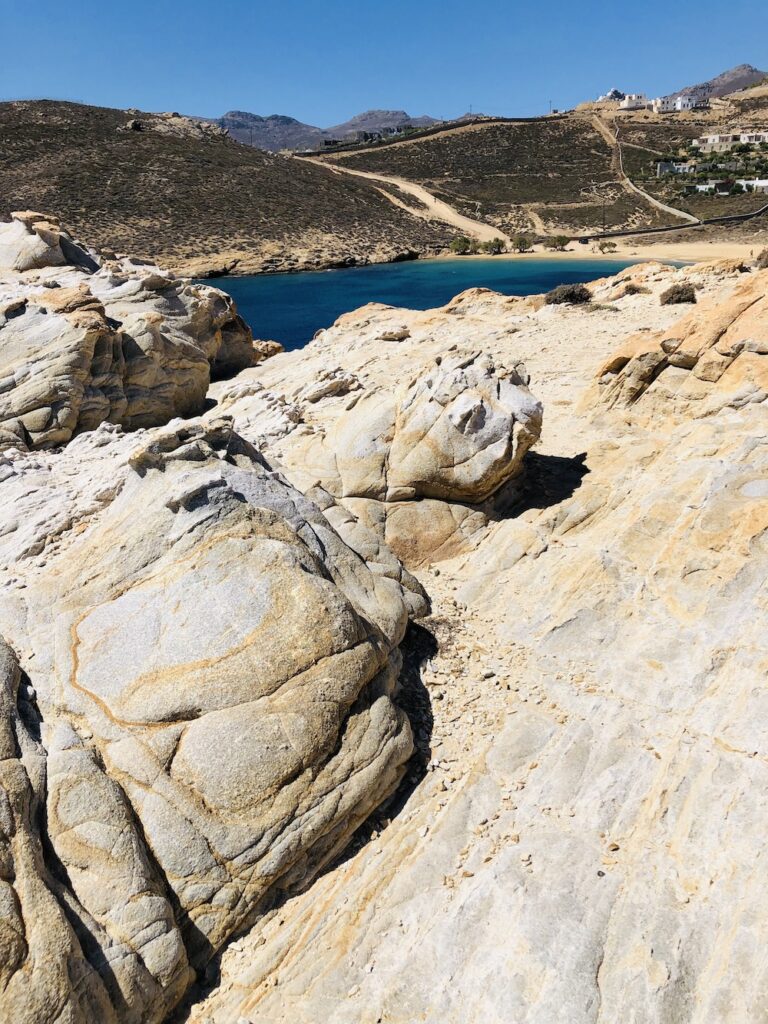
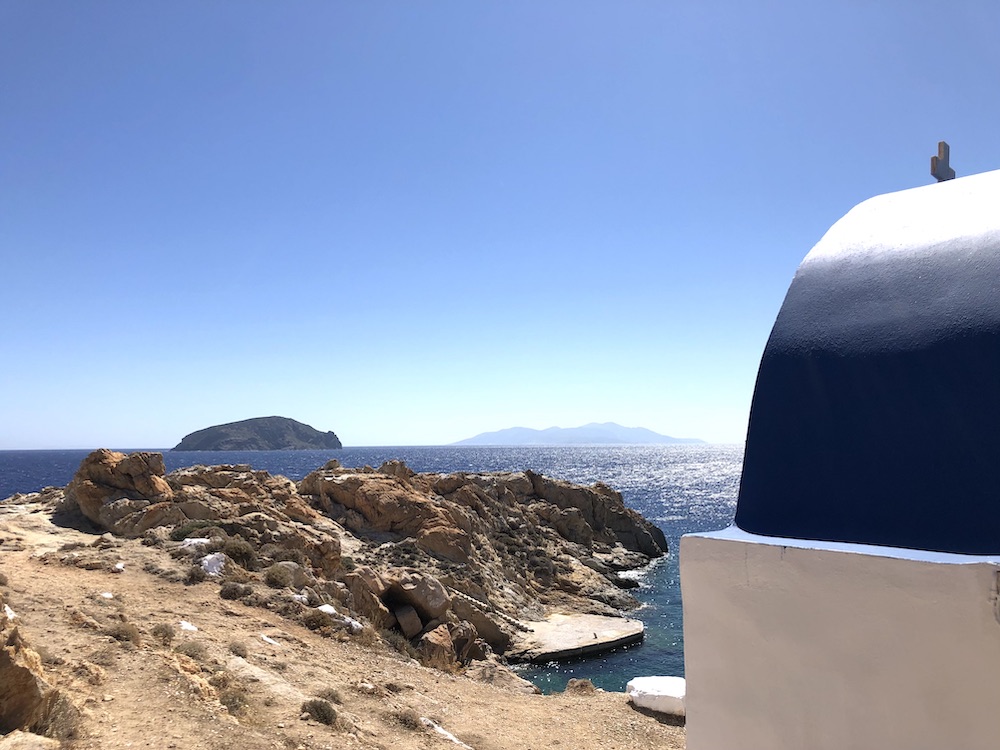

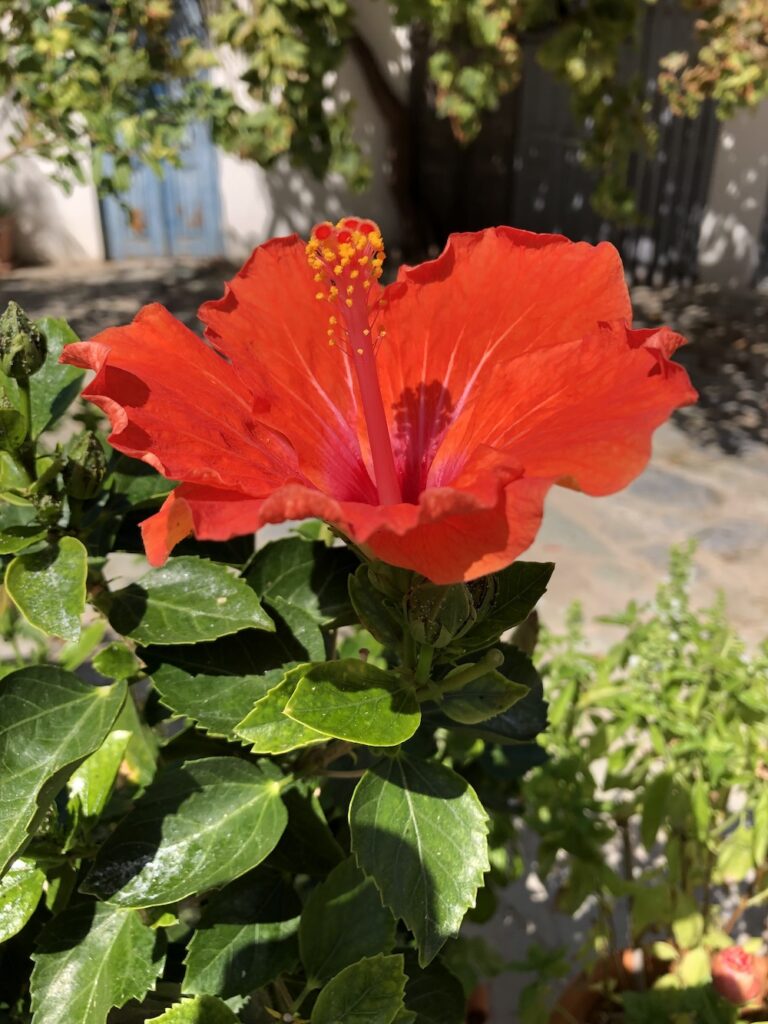
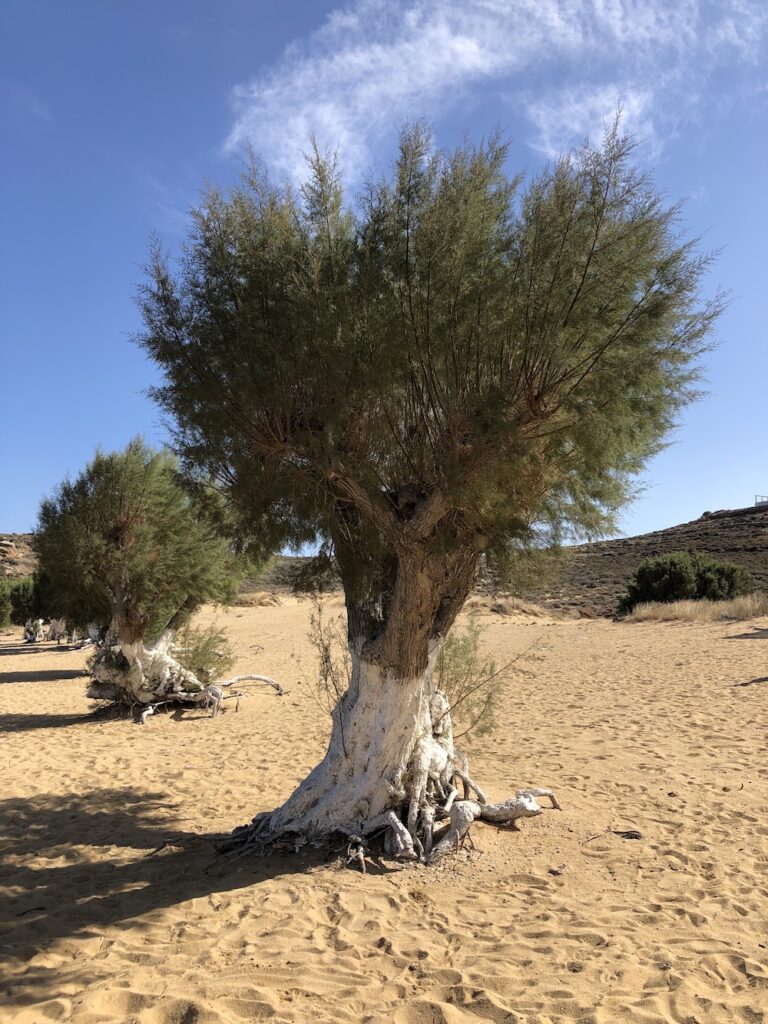
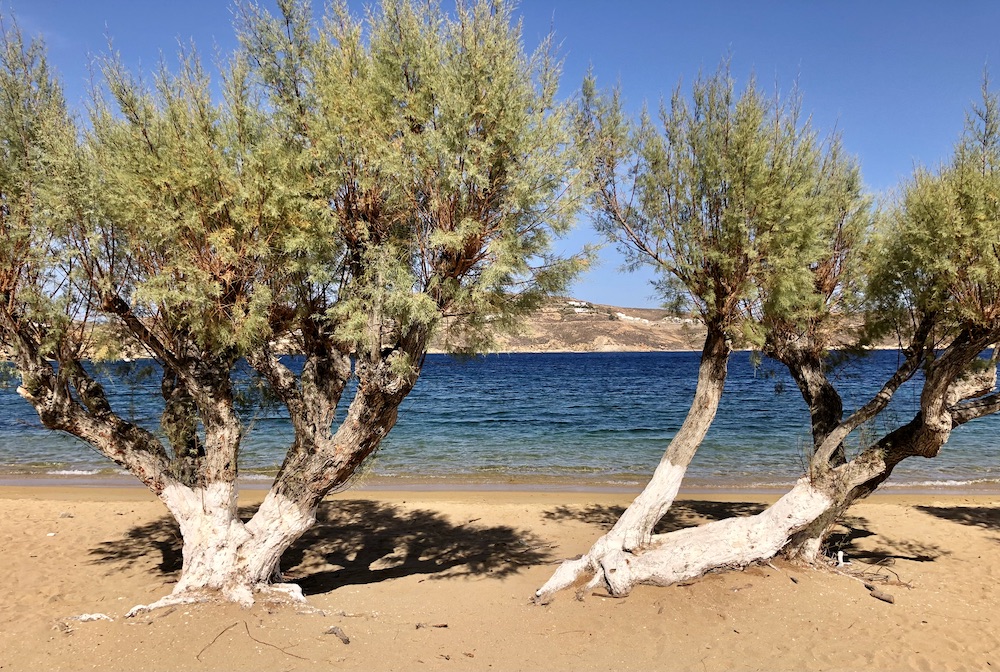
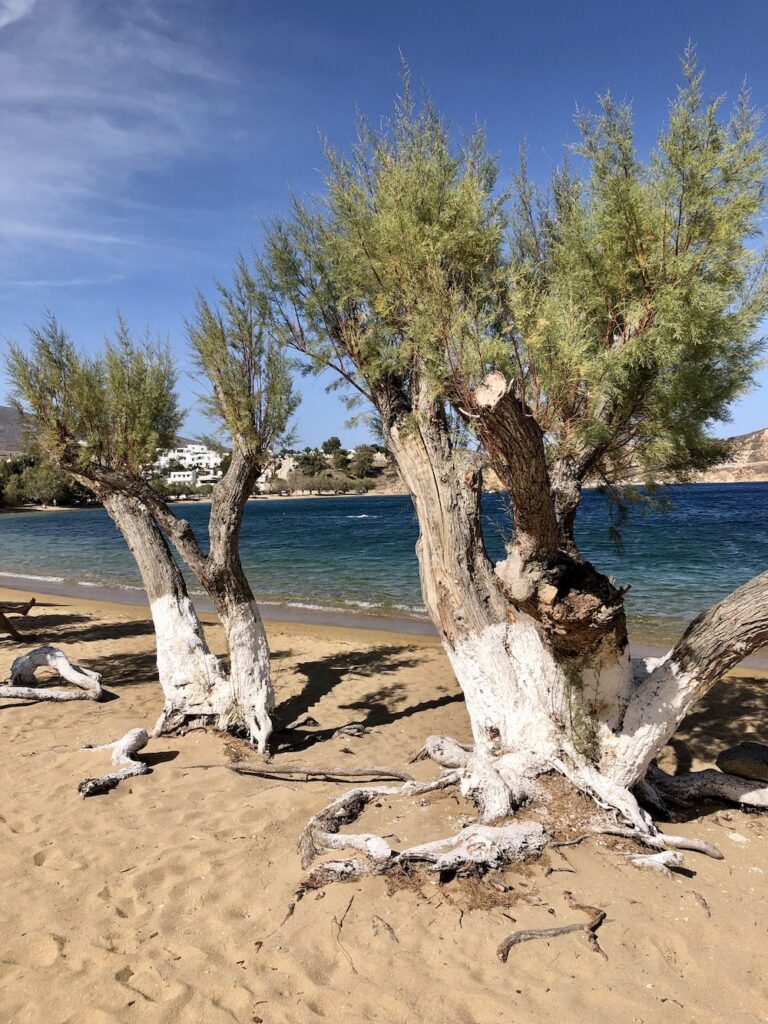
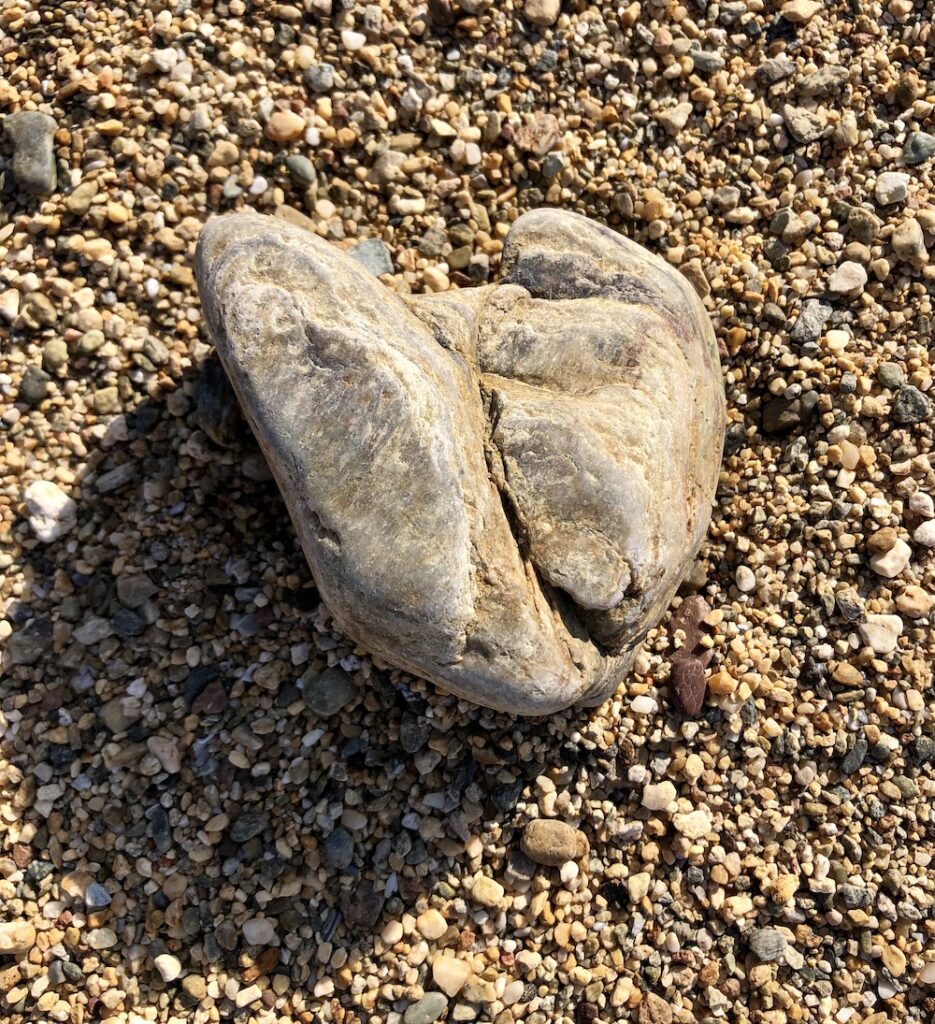
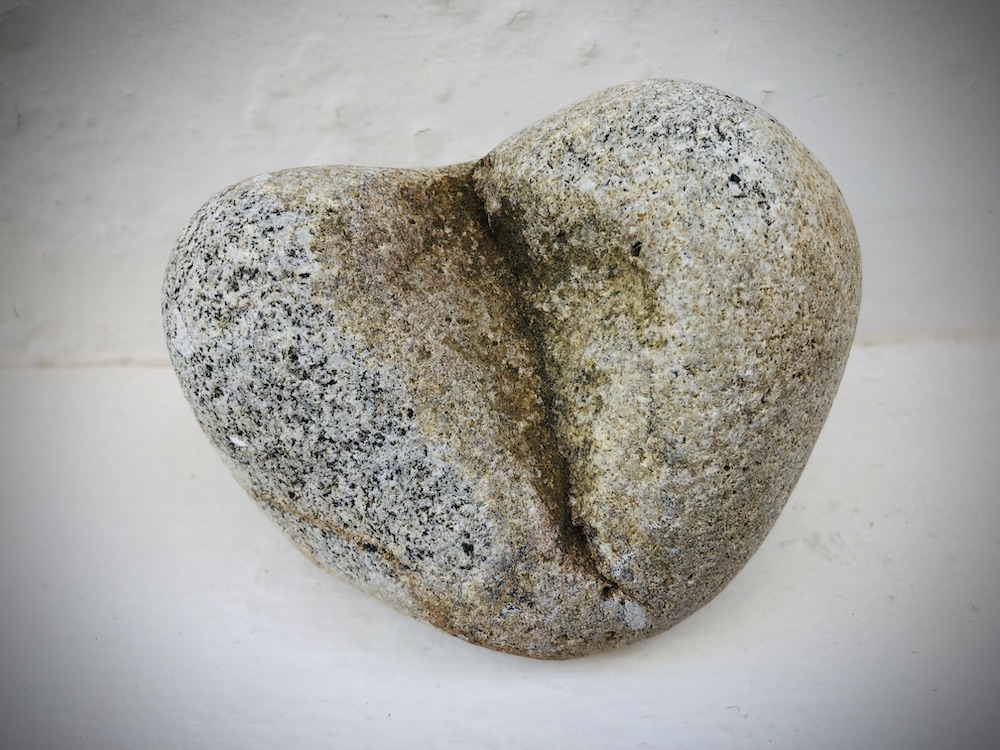
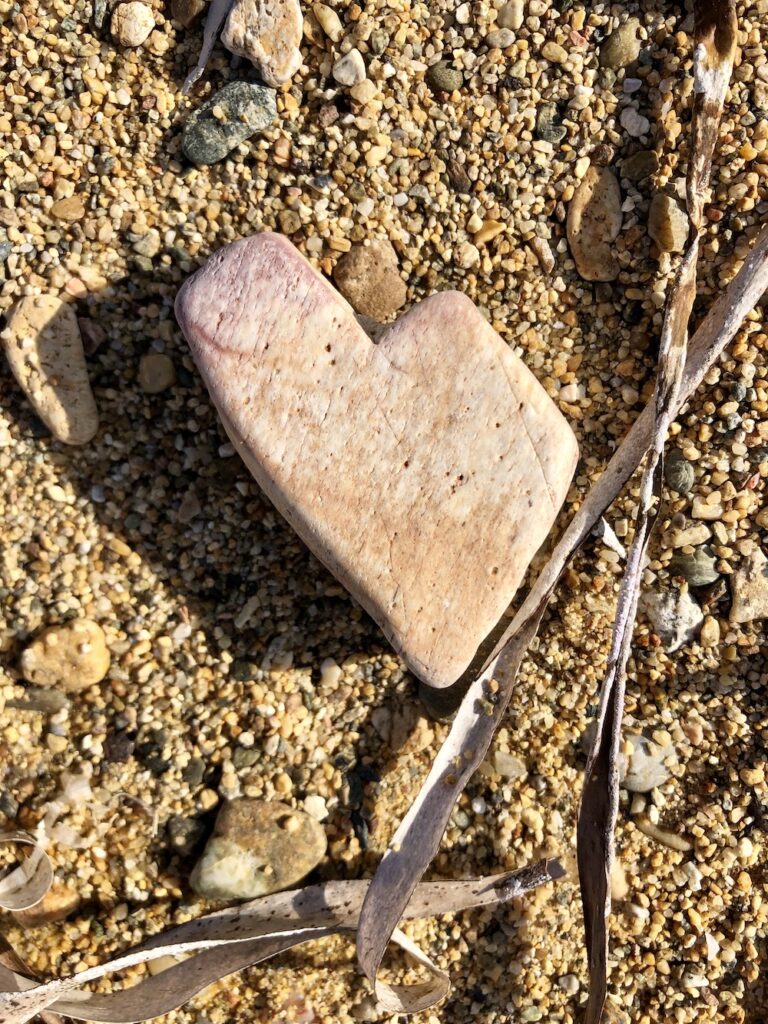
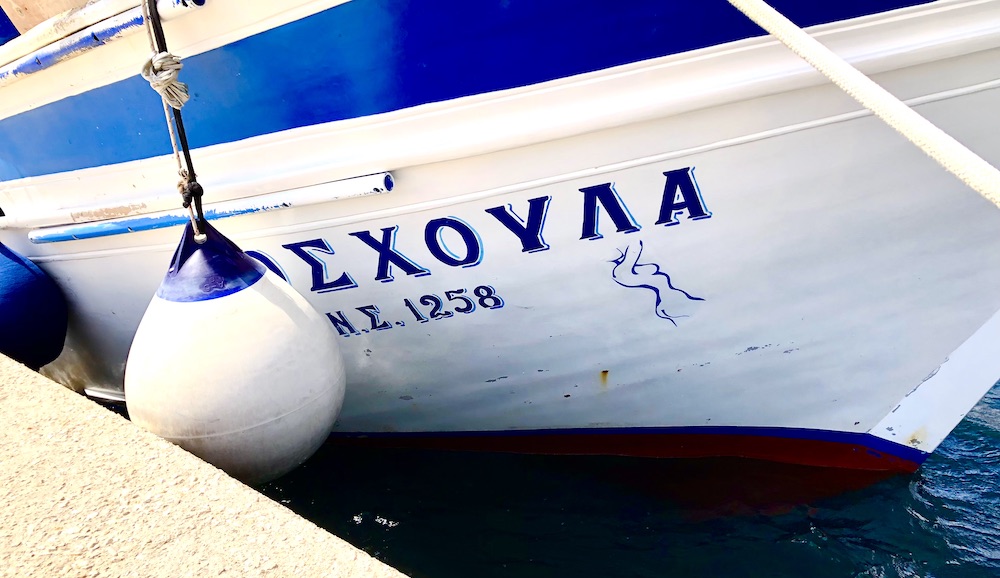
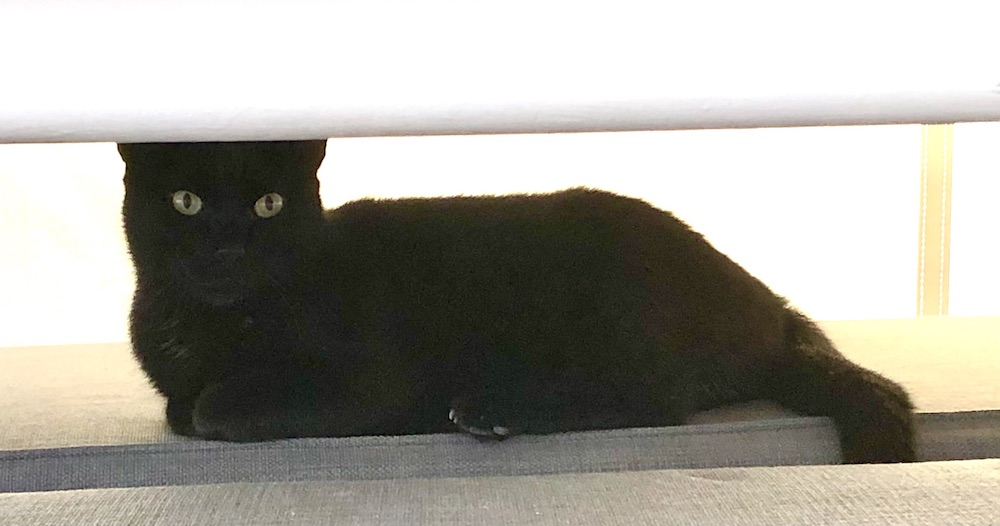
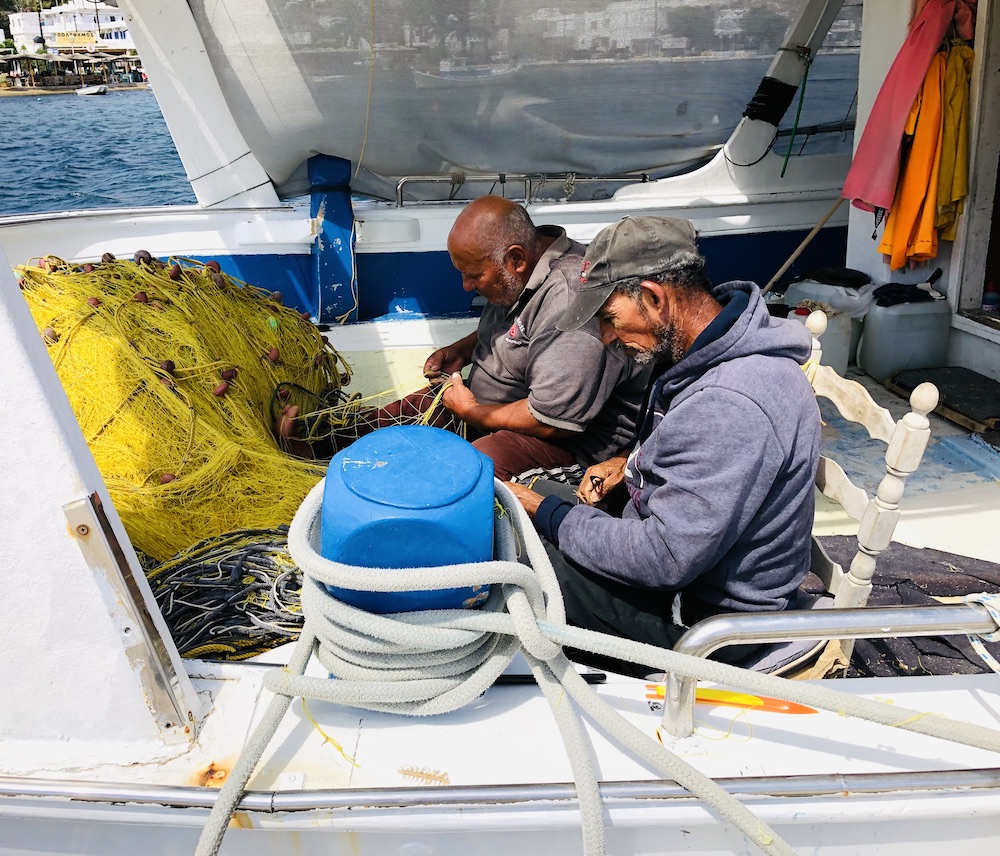
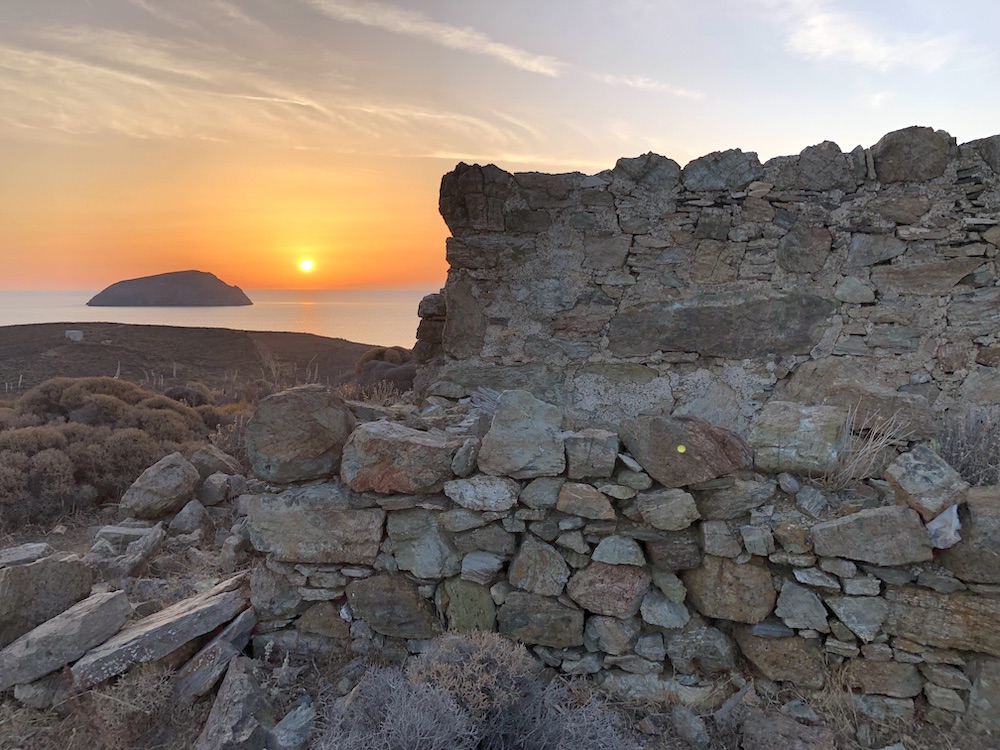
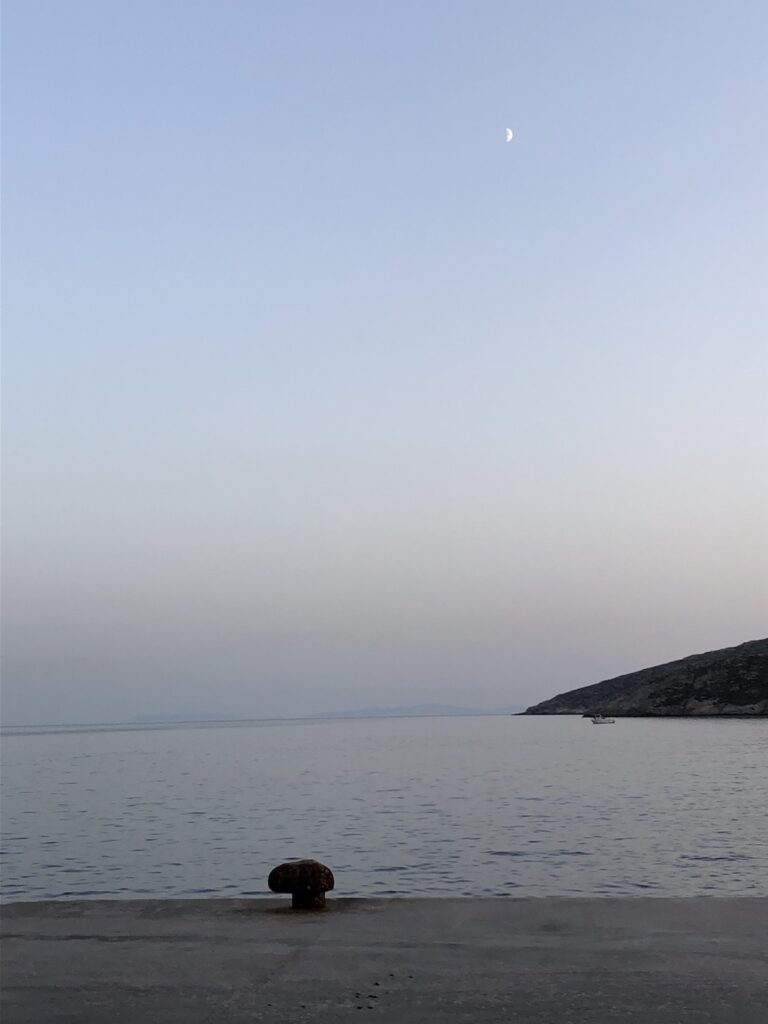
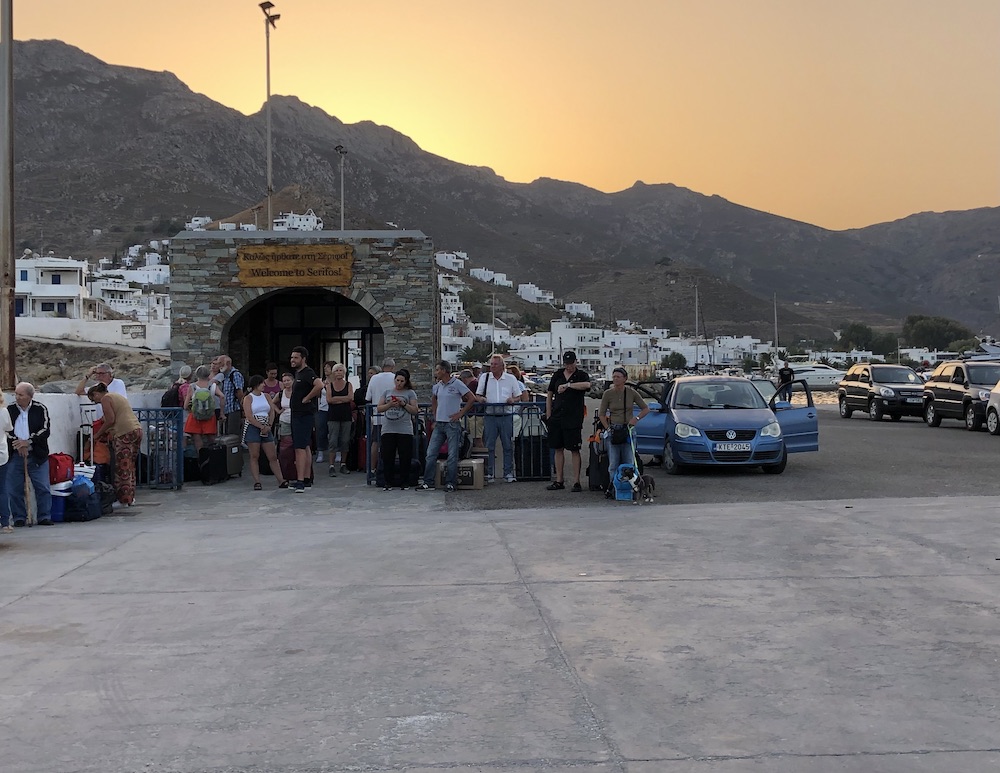
![]()
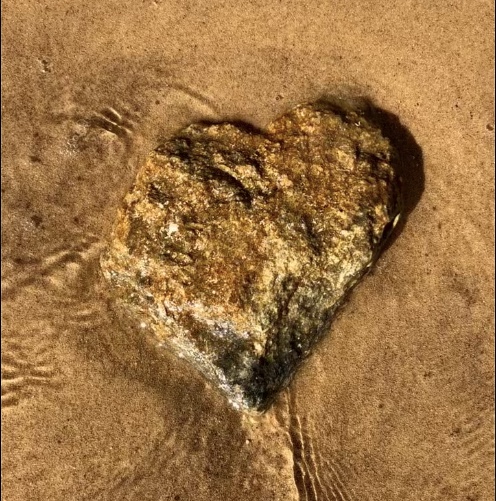
![]()
Practical Information Regarding Serifos
Consult “Matt Barrett’s Greece Guides” website, www.GreekTravel.com, to better plan your trip, and Ferryhopper (download the app/buy tickets online) to book ferry/high-speed catamaran tickets to and from Serifos. We used two maps while on the island: 1) Terrain Editions 303 Serifos GIS Hiking Map (www.terranmaps.gr); and 2) Silvia Krämer’s Free Map, available in a frameable edition from the artist’s shop in Ano Hora, 100% Greek.
We recommend using Airbnb to find lodging on the island. With the COVID pandemic still a reality (and Paxlovid challenging for foreign visitors who fall ill to procure, even in Athens), we still believe masking on flights and ferries advisable and booking accommodation not shared by other visitors the best option on Serifos, which has no airport. We stayed at the Serenity Beach Villa, in Tsilipaki, and cannot more highly recommend it.
We also rented a large, powerful car for the duration of our stay, and advise those whose desire is to see Serifos in its rugged entirety to book, in advance, a four-wheel-drive vehicle through Mr. Vangelis Galanos, at Coralli Car Rental (www.corallirentals.gr; E.info@corallirentals.gr; Tel. 30.22810.51488).
Contact Ms. Maria Grigoriadou, of This Is My Crazy Dream, to rent boats/boat tours of Serifos and nearby islands (crazydream2@outlook.com.gr; Tel. 30.6980.423.331).
In September, when we visited, we found the most reliable places to eat, both lunch and dinner, were the following: Takis: Authentic Greek Cuisine & Seafood, Livadi, Serifos, Tel. 30 22810.51159; Alexandros Cuisine & Coffee Bar, Alexandros Resort, Livadakia Beach, Serifos, www.AlexandrosResort. com; Tel. 6909397774; Porto Vecchio, Livadi, Serifos, Tel. 30.2281.052532; and Stamatis, Avlomonas Beach/Livadi, Serifos; Tel. 30. 2281.051309.
For shopping, we highly recommend, for local and Sifniote fine ceramics, KN Ceramics, Kato Hora, www.knceramics.gr, Tel. 30.22810.51669, info@kerameio.gr; for unique, finely-produced souvenirs, books, Greek clothing, and jewelry, Theta (Think of Serifos) Concept Store, Livadi/Marina, Tel. 30. 22810.51781, https://thinkofserifos.gr/en/, info@thinkofserifos.gr; for stylish European fashions, Calle 31 (Clothing Boutique), Livadi, Tel. 30.693.859.0386; and, for unique artisanal gifts, 100% Greek: Limited Art Editions, Hora, Serifos, Tel. 30.6944.444.225. KN Ceramics is run by Ms. Natassa Kalogeropoulou and a group of highly skilled and creative ceramicists who will ship all over the world. 100% Greek is the creation of Ms. Silvia Krämer: be sure to purchase her own frameable, annotated map of the island and see textiles and clothing she fashions using antique Greek fabrics.
The beaches of Serifos—well over 50—are too numerous even to mention by name here, but I found them (except Avlomenas, which is really an extension of the port of Livadi, and Ganema, Koutalas, and Megalo Livadi, which feature humble tavernas in high season) to be much like the beaches of Mykonos in the 1970s: difficult of access, uncluttered by beach umbrellas and bars, and uncrowded, especially in September, by which time many of the establishments catering solely to tourists have closed. Livadakia, in September, was also an exception, in that the excellent Alexandros Taverna & Coffee Bar was still open, and the little attached resort was still full of European, short-stay tourists. But even Livadakia is difficult to reach by car and has little parking. Forgive me if I do not mention my favorite Serifos beaches here: as a longtime Greek travel writer, I know what damage I and my confrères have done advertising-to-death Greece’s most pristine destinations.
Partial Bibliography
Acts of Faith: The Curches of Serifos, Ioannis Varlas, Transl. Antonios Vitalis, Kanthia Press, 1997. (ISBN: 0-473-04348-3)
Sifnos-Serifos, Havens of Authenticity in the Greek Islands, Denis Roubien, 2021 (ISBN: 979-873-002-840-1)
Serifos, Loris Triantafyllidis, Technokataskevi SA, June 2012 (ISBN: 978-618-80065-0-8)
Serifos Above, Panagiotis Filippopoulos/Windy Pixels, 2022
Seriphos: The White Tower, Ministry of Culture and Sport, General Directorate of Antiquities and Cultural Heritage, 21st Ephorate of Prehistoric and Classical Antiquities, Athens, Greece, 2014. (ISBN: 978-960-386-123-2)
The Magic of Serifos, Robert A. McCabe, Ephorate of Antiquities of Cyclades/Perseus Archaeological Museum, Serifos, July 2023


